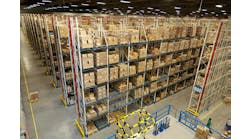What percentage of worldwide consumers are willing to pay for same-day or faster delivery? According to PwC’s 2018 Global Consumer Insights Survey, 88%. Consequently, it’s no surprise that more than half of retailers in North America are now offering same-day delivery in response to this trend.
Let’s put that in perspective. A report by McKinsey & Company just two years ago asked a similar question. At that time, just 23% of customers indicated they were willing to pay extra for same-day or instant delivery.
Challenges Facing the Warehouse
The surge in demand for next-day and same-day service extends beyond e-commerce retailers, as customers increasingly have similar expectations for all distributors. The supply chain will need to adapt existing networks and implement new technologies to keep pace, but this is not something distributors can roll out overnight. So, what is needed to ready a supply chain for same-day delivery and how can distributors prepare their warehouses?
A robust and user-centric warehouse management system (WMS) that delivers real-time insights, yet is flexible enough to scale as operations grow, is key to making distribution businesses run faster, better and more efficiently. This creates significant opportunity for these organizations to add value, stay competitive and boost the company’s reputation within the warehouse. Distributors that provide same-day or next-day delivery increase sales conversion rates and profitability. These same distributors exhibit an industry-leading and contemporary business image.
Operating at Peak Performance
Meeting existing delivery expectations is already proving to be challenging for many organizations; moving to even shorter delivery times may require significant investments in facilities, people and technology. The warehouse is the heart of the supply chain and it is crucial to keeping inventory flowing. Managing a warehouse not only involves inventory monitoring and floor planning, but also entails handling the traffic coming in and out of the warehouse. A WMS should help manage both incoming and outgoing cargo and transportation.
A WMS can also help facility managers prepare for and resolve a host of organizational challenges involved with executing same-day or next-day delivery. For example, a WMS allows a worker to perform their tasks in a more streamlined and efficient manner. In fact, warehouse managers can use the WMS to create rules-based processes to assign the right tasks to the right people in the right order. The WMS will ensure that same-day or next-day orders are prioritized properly such that they are getting picked, packed and shipped in the right order relative to the other orders in the system.
Integrated Shipping and Dimensioning Solutions
Many WMS vendors have already added integrated shipping systems to their platforms. A WMS with user-friendly parcel shipping integration software can simplify warehouse shipping, package tracking and route management to get products to customers quickly, securely and affordably. Software that provides a multi-carrier shipping solution and automatically finds the fastest option or lowest available shipping rate from all carriers is critical for meeting expedited shipping delivery schedules.
Dimensioning is another aspect of shipment preparation that can help take your warehouse to the next level. For example, 3-D technology now makes it easier to calculate the best packaging and help determine the best shipping option. Plug this technology into a dimensioning software solution, coupled with a WMS, and you’ve got a quicker way to get a product into packaging and out the door, which can help save both time and money.
Meet (and Exceed) Customer Expectations, or Else
Lastly, the consistent execution of same-day or next-day delivery can have an impact on customer experience and brand loyalty. Back in the day, when business was done on the golf course, it often came down to with whom you had an established relationship and felt good about. These days, it’s very easy for customers to take their business elsewhere. Distributors who recognize this and strive to consistently deliver on their promise will continue to impress customers, hold on to them longer and grow business as a result.
Traditional brick-and-mortar businesses are facing disruption and dissolution like never before, so the ability to respond to changing customer requirements and expectations is more critical than ever. In other words, warehouses will soon be ruled by our changing customer expectations and the need for instantaneous fulfillment and expedited delivery. Whether it’s speed of delivery or strength of overall distribution strategy, only the fittest—and fastest—will survive.
Eric Allais is president and CEO of PathGuide Technologies Inc., a provider of warehouse management systems. He has over 30 years of experience in marketing, product management and sector analysis in the automated data collection industry, including warehouse management practices in wholesale distribution.



